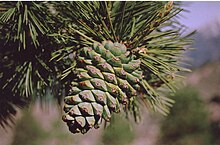Pinus gerardiana
| Chilgoza pine | |
|---|---|

| |
| Pinus gerardiana female cone | |
| Scientific classification | |
| Kingdom: | Plantae |
| Clade: | Tracheophytes |
| Clade: | Gymnospermae |
| Division: | Pinophyta |
| Class: | Pinopsida |
| Order: | Pinales |
| Family: | Pinaceae |
| Genus: | Pinus |
| Subgenus: | P. subg. Strobus |
| Section: | P. sect. Quinquefoliae |
| Subsection: | P. subsect. Gerardianae |
| Species: | P. gerardiana
|
| Binomial name | |
| Pinus gerardiana | |
| Synonyms[2] | |
| |
Pinus gerardiana, commonly known as the chilghoza pine or neja, is a pine native to the northwestern Himalayas in Afghanistan, northern Pakistan, Waziristan and northwestern India, growing at elevations of 1,800–3,350 metres (5,910–10,990 ft).[1] It often occurs in association with Cedrus deodara,[3] and Pinus wallichiana.
Description
[edit]The trees are 15–25 metres (49–82 ft) tall with usually deep, wide and open crowns with long, erect branches. However, crowns are narrower and shallower in dense forests. The bark is very flaky, peeling to reveal light greyish-green patches. The branchlets are smooth and olive-green. The leaves are needle-like, in groups of three, 6–10 centimetres (2.4–3.9 in) long, and spread stiffly. They are glossy green on the outer surface, with blue-green stomatal lines on the inner face; their sheaths fall in the first year. The cones are 10–18 centimetres (3.9–7.1 in) long and 9–11 centimetres (3.5–4.3 in) wide when open, with wrinkled, reflexed apophyses and an umbo curved inward at the base. The seeds (pine nuts) are 17–23 millimetres (0.67–0.91 in) long and 5–7 millimetres (0.20–0.28 in) broad, with a thin shell and a rudimentary wing.[3]
Similar species
[edit]P. gerardiana is similar to the closely related lacebark pine (Pinus bungeana), another pine with flaking bark. However, P. gerardiana has denser, longer, and more slender needles, as well as larger cones than P. bungeana.[4]
Taxonomy
[edit]The scientific name commemorates Captain Patrick Gerard, a British army officer of the Bengal Native Infantry.[4] who collected it during a 1823–25 military survey in India.[3]
It was first published in A.B.Lambert, Descr. Pinus, ed. 3, 2: 144 bis in 1832.[2]
Distribution and habitat
[edit]P. gerardiana is native to Afghanistan, Tibet in China, Jammu-Kashmir in India, and Pakistan.[2] Since it grows at high, mountainous altitudes, it inhabits valley floors in between high mountain ranges in the Himalayas, tending to grow among open vegetation on dry, sunny slopes.[1]
Conservation
[edit]In 2011, this species was listed as near threatened on the IUCN Red List of Threatened Species. It was previously listed as Lower Risk/near threatened in 1998. P. gerardina forests have declined by an estimated 30% due to conversion of pine forests to farmland, intensive grazing, and overharvesting of the seed cones and timber for firewood.[1] The Himachal Pradesh State Forest Department has tried artificial regeneration of chilgoza pine at many places. However, performance of seedlings was found to be very poor.[citation needed]

Ecology
[edit]Since their seeds do not have a wing capable of enabling effective dispersal by wind, the seeds of P. gerardiana are dispersed by birds.[1] The Eurasian nutcracker (Nucifraga caryocatactes subsp. multipunctata) is one such species that does so.[3]
P. gerardiana is also a secondary host for Himalayan dwarf mistletoe.[5]
Uses
[edit]Older trees that don't produce enough cones to harvest pine nuts from are felled for firewood. The wood is also used for local light construction and carpentry.[1]
Food
[edit]Chilghoza seeds, or pine nuts, are harvested for consumption in autumn and early winter by knocking the cones off of the trees. The trees and seed harvesting rights are owned by local mountain clans and villages in some areas, from which they may be exported to markets in the northern Indian plains. In traditional harvesting practices, enough seeds are left behind for the forest to regenerate, but in areas controlled by private contractors, all cones are harvested.[1]
Chilgoza pine nuts are rich in carbohydrates and proteins. The seeds are locally referred to and marketed as "chilgoza", "neja" (singular) or "neje" (plural). Chilghoza is one of the most important cash crops of Afghanistan,[6][7][8] as well as of Kinnaur and Pangi Valley of Chamba district of Himachal Pradesh, India.[9] They are sold at approximately $20–$53 per kilograms in India.[citation needed]
References
[edit]- ^ a b c d e f g Farjon, A. (2013). "Pinus gerardiana". IUCN Red List of Threatened Species. 2013: e.T34189A2850009. doi:10.2305/IUCN.UK.2013-1.RLTS.T34189A2850009.en. Retrieved 15 February 2023.
- ^ a b c "Pinus gerardiana Wall. ex D.Don | Plants of the World Online | Kew Science". Plants of the World Online. Retrieved 30 October 2023.
- ^ a b c d Earle, Christopher J., ed. (2018). "Pinus gerardiana". The Gymnosperm Database.
- ^ a b Dallimore, William; Jackson, Albert Bruce (1923). "Pinus". A handbook of Coniferae, including Ginkgoaceæ (1 ed.). New York: Longmans, Green & Co. pp. 357–470 [396–397]. doi:10.5962/bhl.title.15657.
- ^ Hawksworth, Frank G.; Wiens, Delbert (April 1998). Dwarf Mistletoes. DIANE Publishing. pp. 264–265. ISBN 978-0-7881-4201-7. Retrieved 16 April 2022.
- ^ ZS (6 November 2022). "Pine Nuts Export Hike Increase in World Market". Bakhtar News Agency. Kabul, Afghanistan. Retrieved 3 January 2023.
- ^ "Afghanistan Exports At Least 5,000 Tons of Pine Nuts". TOLOnews. 4 January 2023. Retrieved 4 January 2023.
- ^ "China largest importer of Afghan pine nuts: MoCI". Pajhwok Afghan News. Kabul, Afghanistan. 3 January 2023. Retrieved 3 January 2023.
- ^ "Challenge to save Chilgoza & wild mushrooms in HP". United News of India. 22 June 2018. Retrieved 14 February 2023.

